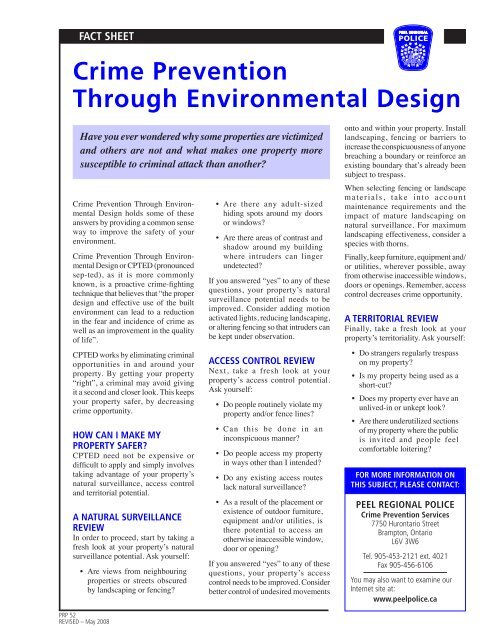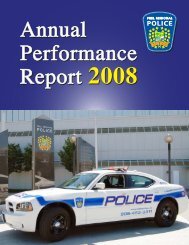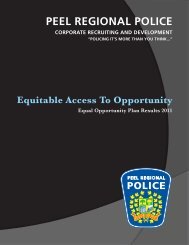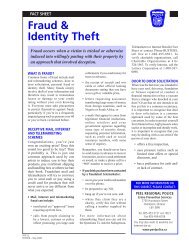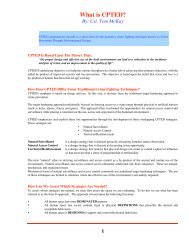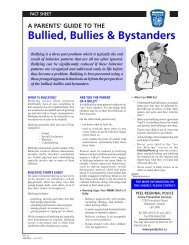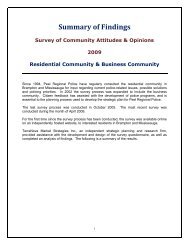Crime Prevention Through Environmental Design - Peel Regional ...
Crime Prevention Through Environmental Design - Peel Regional ...
Crime Prevention Through Environmental Design - Peel Regional ...
You also want an ePaper? Increase the reach of your titles
YUMPU automatically turns print PDFs into web optimized ePapers that Google loves.
Fact Sheet<br />
<strong>Crime</strong> <strong>Prevention</strong><br />
<strong>Through</strong> <strong>Environmental</strong> <strong>Design</strong><br />
Have you ever wondered why some properties are victimized<br />
and others are not and what makes one property more<br />
susceptible to criminal attack than another<br />
<strong>Crime</strong> <strong>Prevention</strong> <strong>Through</strong> <strong>Environmental</strong><br />
<strong>Design</strong> holds some of these<br />
answers by providing a common sense<br />
way to improve the safety of your<br />
environment.<br />
<strong>Crime</strong> <strong>Prevention</strong> <strong>Through</strong> <strong>Environmental</strong><br />
<strong>Design</strong> or CPTED (pronounced<br />
sep-ted), as it is more commonly<br />
known, is a proactive crime-fighting<br />
technique that believes that “the proper<br />
design and effective use of the built<br />
environment can lead to a reduction<br />
in the fear and incidence of crime as<br />
well as an improvement in the quality<br />
of life”.<br />
CPTED works by eliminating criminal<br />
opportunities in and around your<br />
property. By getting your property<br />
“right”, a criminal may avoid giving<br />
it a second and closer look. This keeps<br />
your property safer, by decreasing<br />
crime opportunity.<br />
How can I make my<br />
property safer<br />
CPTED need not be expensive or<br />
difficult to apply and simply involves<br />
taking advantage of your property’s<br />
natural surveillance, access control<br />
and territorial potential.<br />
A Natural Surveillance<br />
Review<br />
In order to proceed, start by taking a<br />
fresh look at your property’s natural<br />
surveillance potential. Ask yourself:<br />
• Are views from neighbouring<br />
properties or streets obscured<br />
by landscaping or fencing<br />
• Are there any adult-sized<br />
hiding spots around my doors<br />
or windows<br />
• Are there areas of contrast and<br />
shadow around my building<br />
where intruders can linger<br />
undetected<br />
If you answered “yes” to any of these<br />
questions, your property’s natural<br />
surveillance potential needs to be<br />
improved. Consider adding motion<br />
activated lights, reducing landscaping,<br />
or altering fencing so that intruders can<br />
be kept under observation.<br />
Access Control Review<br />
Next, take a fresh look at your<br />
property’s access control potential.<br />
Ask yourself:<br />
• Do people routinely violate my<br />
property and/or fence lines<br />
• Can this be done in an<br />
inconspicuous manner<br />
• Do people access my property<br />
in ways other than I intended<br />
• Do any existing access routes<br />
lack natural surveillance<br />
• As a result of the placement or<br />
existence of outdoor furniture,<br />
equipment and/or utilities, is<br />
there potential to access an<br />
otherwise inaccessible window,<br />
door or opening<br />
If you answered “yes” to any of these<br />
questions, your property’s access<br />
control needs to be improved. Consider<br />
better control of undesired movements<br />
onto and within your property. Install<br />
landscaping, fencing or barriers to<br />
increase the conspicuousness of anyone<br />
breaching a boundary or reinforce an<br />
existing boundary that’s already been<br />
subject to trespass.<br />
When selecting fencing or landscape<br />
materials, take into account<br />
maintenance requirements and the<br />
impact of mature landscaping on<br />
natural surveillance. For maximum<br />
landscaping effectiveness, consider a<br />
species with thorns.<br />
Finally, keep furniture, equipment and/<br />
or utilities, wherever possible, away<br />
from otherwise inaccessible windows,<br />
doors or openings. Remember, access<br />
control decreases crime opportunity.<br />
A Territorial Review<br />
Finally, take a fresh look at your<br />
property’s territoriality. Ask yourself:<br />
• Do strangers regularly trespass<br />
on my property<br />
• Is my property being used as a<br />
short-cut<br />
• Does my property ever have an<br />
unlived-in or unkept look<br />
• Are there underutilized sections<br />
of my property where the public<br />
is invited and people feel<br />
comfortable loitering<br />
For more information on<br />
this subject, please contact:<br />
<strong>Peel</strong> <strong>Regional</strong> Police<br />
<strong>Crime</strong> <strong>Prevention</strong> Services<br />
7750 Hurontario Street<br />
Brampton, Ontario<br />
L6V 3W6<br />
Tel. 905-453-2121 ext. 4021<br />
Fax 905-456-6106<br />
You may also want to examine our<br />
Internet site at:<br />
www.peelpolice.ca<br />
PRP 52<br />
Revised – May 2008
<strong>Crime</strong> <strong>Prevention</strong> <strong>Through</strong> <strong>Environmental</strong> <strong>Design</strong><br />
Fact Sheet<br />
If you answered “yes” to any of these<br />
questions, your property’s territoriality<br />
needs to be improved. Take steps to<br />
rectify this by creating or extending<br />
a sphere of influence around your<br />
property.<br />
For businesses and residences, this<br />
can be done through strategically<br />
placed markers, flowerbeds, low<br />
fences, walls, hedges, signage; better<br />
and/or more timely maintenance, and<br />
where the public is invited, assigning<br />
purposes to “leftover spaces”.<br />
For residences, don’t forget to create<br />
an “illusion of occupancy”. This is<br />
extremely important in deterring<br />
thieves. Accomplish this by making<br />
sure your lawn is maintained, your<br />
driveway is shoveled and your circulars<br />
are picked up. Use timers to control<br />
your lights and have someone check<br />
on your property. And don’t forget to<br />
join and participate in Neighbourhood<br />
Watch and for businesses, Business<br />
<strong>Crime</strong> Watch.<br />
merchandisers have discovered that the application of CPTED techniques have<br />
reportedly increased sales by as much as 33% and decreased security problems<br />
by 50%.<br />
Maximizing CPTED benefits<br />
CPTED provides the opportunity to design in crime prevention and design out<br />
crime. For maximum benefits, CPTED should be applied at the design or planning<br />
stage when these benefits can be achieved at little or no cost.<br />
NOTES<br />
Don ‘t forget about<br />
Target Hardening<br />
For maximum crime prevention<br />
benefits, target hardening should be<br />
applied with CPTED principles. For<br />
Target Hardening advice, please see<br />
the Home Security Fact Sheet series.<br />
CPTED’s proven track<br />
record<br />
CPTED techniques are directed against<br />
crimes of opportunity. Where these<br />
techniques have been applied to<br />
problem settings, crimes of opportunity<br />
have decreased by as much as 90%.<br />
What about interior<br />
applications<br />
CPTED is equally effective when<br />
applied to building or store interiors.<br />
CPTED’s universality results from<br />
its ability to help various disciplines<br />
do a better job of achieving their<br />
primary objective. <strong>Design</strong>ers and


